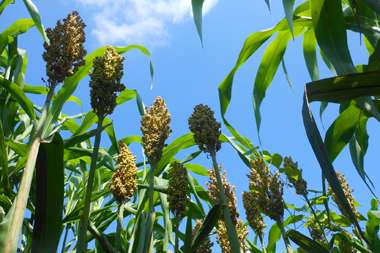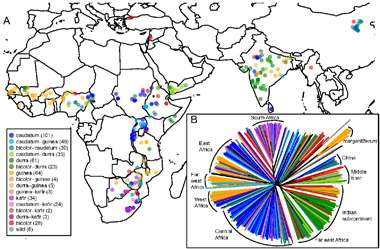Unlocking sorghum's gene bank: Adapting agriculture to a changing climate

(Phys.org)—Climate change poses a major challenge to humanity's ability to feed its growing population. But a new study of sorghum, led by Stephen Kresovich and Geoff Morris of the University of South Carolina, promises to make this crop an invaluable asset in facing that challenge. Just published in the Proceedings of the National Academy of Sciences (PNAS), the paper puts genetic tools into the hands of scientists and plant breeders to help accelerate their ability to adapt sorghum to new conditions.
A hardy cereal crop that was first domesticated in the Horn of Africa some 10,000 years ago, sorghum is now cultivated worldwide, from Texas to China. Sorghum is a particularly drought-tolerant grain and an essential part of the diet for 500 million people, chiefly in sub-Saharan Africa and India. In the U.S., where it is primarily grown for livestock feed, sorghum's climate resilience was highlighted during the devastating summer drought of 2012.
A large international effort decoded the genome of the species cultivated for food, Sorghum bicolor, which was published in the journal Nature in 2009. That genome represents the genetic accounting of a single individual of sorghum. But as individual humans have genetic differences that underlie physical differences such as eye color, so do individual plants of sorghum. The focus of the current effort was to establish the connections between gene differences and physical differences – a detailed understanding of those connections will constitute a tremendous tool for plant breeders.
The team behind the current PNAS publication – which also included researchers at Cornell University, the International Crops Research Institute for the Semi-Arid Tropics in India and Niger, the University of Illinois and the U.S. Department of Agriculture – used genotyping-by-sequencing (GBS) to determine the individual genetic makeup of 971 sorghum varieties taken from world-wide seed collections. The scientists identified more than a quarter million single-nucleotide polymorphisms (SNPs); that is, single letters in the genetic code where individual variants of sorghum can differ.

The results were possible thanks to a tremendous genetic resource that was built over many years, and largely before genotyping was even technically possible. For almost a century, sorghum seeds from a variety of international locations have been stored in seed banks, with dates and geographic origins often noted with each sample.
"We're taking advantage of the incredible diversity found in the gene bank," said Morris, a research assistant professor at USC and lead author on the paper.
One subject of particular scrutiny in the paper was the genetic control of the panicle, the structure on the top of the plant that holds the grains. This feature is an important consideration for successful breeding, particularly when climate is a consideration. Closely packed grains, for example, are preferred for maximum crop yield in dry areas, but in places with abundant rainfall, more spacing is desirable to allow grains dry out more readily and reduce crop losses from moisture-caused disease.
The researchers identified genes that likely contribute to this physical feature, and they also mapped them geographically according to the source of the original seed. The result was insight into how different variants of the genes spread according to regional climates – which varied widely in the study, from the edge of the Sahara to the rainy highlands of east Africa.
The results will "provide resources for everyone around the world who breeds sorghum," Morris said. "The goal is to do it faster than the way it's been done traditionally, which takes years of growing and crossing and testing."
That's particularly important because the semi-arid regions where sorghum is a staple food are predicted to be most adversely affected by climate change. Sorghum varieties that currently thrive there will have to be bred for new conditions, a time-consuming process. "The challenges facing agriculture are getting more severe, so the tools that we have for crop improvement have to keep pace," Morris said.
A further step forward will involve genomic selection, another collaborative effort planned for the coming year that will again involve Kresovich, the SmartState Endowed Chair of Genomics at USC and senior author on the PNAS paper. With that method, in which computers are used to select the most promising candidates to test in the field, "you might be able to take years off the breeding cycle," Morris said. "Instead of having to grow thousands of varieties, you test thousands of varieties 'in silico' and pick a few hundred of the best for growing the next generation."
More information: www.pnas.org/content/early/2012/12/19/1215985110
Journal information: Proceedings of the National Academy of Sciences , Nature
Provided by University of South Carolina


















